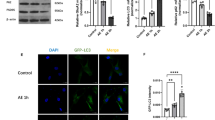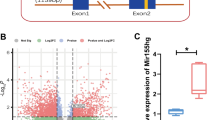Abstract
Prenatal ethanol exposure can cause extensive apoptotic neurodegeneration throughout the developing central nervous system (CNS), which results in cognitive deficits and memory decline. However, the underlying mechanisms need further study. Single-minded 2 (Sim2), a transcriptional repressor, is reportedly involved in diseases that impair learning and memory, such as Down syndrome (DS) and Alzheimer’s disease. It is still unknown whether Sim2 is involved in regulating ethanol-mediated neuronal injury that might ultimately lead to neuronal dysfunction and subsequent learning and memory deficits. To study the effects of ethanol on Sim2 expression and neuronal injury, we used animal models and cell culture experiments. Our results indicated that in SH-SY5Y cells, ethanol exposure increased Sim2 expression and levels of cleaved caspase 3, which is a marker for cells undergoing apoptosis. Silencing Sim2 expression attenuated caspase 3 activation and cellular apoptosis. We also found that protein kinase A (PKA) activation induced Sim2 expression, as did ethanol. Inhibiting the PKA signaling pathway with H-89 decreased Sim2 expression and cleavage of caspase 3 that was induced by ethanol in vivo and in vitro. We further found that PKA regulated Sim2 expression at the transcriptional level. These results demonstrate that ethanol leads to increased Sim2 expression via the PKA pathway, ultimately resulting in apoptotic cell death.








Similar content being viewed by others
References
Jones KL, Smith DW (1973) Recognition of the fetal alcohol syndrome in early infancy. Lancet 302(7836):999–1001
Malone M, Koren G (2012) Alcohol-induced behavioural problems in fetal alcohol spectrum disorders versus confounding behavioural problems. J Popul Ther Clin Pharmacol 19(1):e32–e40
Willoughby KA, Sheard ED, Nash K, Rovet J (2008) Effects of prenatal alcohol exposure on hippocampal volume, verbal learning, and verbal and spatial recall in late childhood. J Int Neuropsychol Soc 14(6):1022–1033
May PA, Gossage JP (2001) Estimating the prevalence of fetal alcohol syndrome. A summary. Alcohol Res Health 25(3):159–167
Sowell ER, Mattson SN, Kan E, Thompson PM, Riley EP, Toga AW (2008) Abnormal cortical thickness and brain-behavior correlation patterns in individuals with heavy prenatal alcohol exposure. Cereb Cortex 18(1):136–144
Archibald SL, Fennema-Notestine C, Gamst A, Riley EP, Mattson SN, Jernigan TL (2001) Brain dysmorphology in individuals with severe prenatal alcohol exposure. Dev Med Child Neurol 43(3):148–154
Memo L, Gnoato E, Caminiti S, Pichini S, Tarani L (2013) Fetal alcohol spectrum disorders and fetal alcohol syndrome: the state of the art and new diagnostic tools. Early Hum Dev 89(Suppl 1):S40–S43
Climent E, Pascual M, Renau-Piqueras J, Guerri C (2002) Ethanol exposure enhances cell death in the developing cerebral cortex: role of brain-derived neurotrophic factor and its signaling pathways. J Neurosci Res 68(2):213–225
Guerri C (2002) Mechanisms involved in central nervous system dysfunctions induced by prenatal ethanol exposure. Neurotox Res 4(4):327–335
Dikranian K, Ishimaru MJ, Tenkova T, Labruyere J, Qin YQ, Ikonomidou C, Olney JW (2001) Apoptosis in the in vivo mammalian forebrain. Neurobiol Dis 8(3):359–379
Dikranian K, Qin YQ, Labruyere J, Nemmers B, Olney JW (2005) Ethanol-induced neuroapoptosis in the developing rodent cerebellum and related brain stem structures. Brain Res Dev Brain Res 155(1):1–13
Ikonomidou C (2009) Triggers of apoptosis in the immature brain. Brain Dev 31(7):488–492
Chopra K, Tiwari V (2012) Alcoholic neuropathy: possible mechanisms and future treatment possibilities. Br J Clin Pharmacol 73(3):348–362
Olney JW, Wozniak DF, Farber NB, Jevtovic-Todorovic V, Bittigau P, Ikonomidou C (2002) The enigma of fetal alcohol neurotoxicity. Ann Med 34(2):109–119
Blanchard J, Bolognin S, Chohan MO, Rabe A, Iqbal K, Grundke-Iqbal I (2011) Rescue of synaptic failure and alleviation of learning and memory impairments in a trisomic mouse model of down syndrome. J Neuropathol Exp Neurol 70(12):1070–1079
Solzak JP, Liang Y, Zhou FC, Roper RJ (2013) Commonality in down and fetal alcohol syndromes. Birth Defects Res A Clin Mol Teratol 97(4):187–197
Rosales-Reynoso MA, Ochoa-Hernandez AB, Juarez-Vazquez CI, Barros-Nunez P (2012) Alzheimer’s disease and fragile X syndrome: the Wnt/ss-catenin pathway as a common biological mechanism. Rev Neurol 55(9):543–548
Wang X, Song Y, Chen L, Zhuang G, Zhang J, Li M, Meng XF (2013) Contribution of single-minded 2 to hyperglycaemia-induced neurotoxicity. Neurotoxicology 35:106–112
Chatterjee A, Dutta S, Sinha S, Mukhopadhyay K (2011) Exploratory investigation on functional significance of ETS2 and SIM2 genes in down syndrome. Dis Markers 31(5):247–257
Julien C, Tremblay C, Bendjelloul F, Phivilay A, Coulombe MA, Emond V, Calon F (2008) Decreased drebrin mRNA expression in Alzheimer disease: correlation with tau pathology. J Neurosci Res 86(10):2292–2302
Chrast R, Scott HS, Madani R, Huber L, Wolfer DP, Prinz M, Aguzzi A, Lipp HP, Antonarakis SE (2000) Mice trisomic for a bacterial artificial chromosome with the single-minded 2 gene (Sim2) show phenotypes similar to some of those present in the partial trisomy 16 mouse models of Down syndrome. Hum Mol Genet 9(12):1853–1864
Thomas JB, Crews ST, Goodman CS (1988) Molecular genetics of the single-minded locus: a gene involved in the development of the Drosophila nervous system. Cell 52(1):133–141
Bernstein HG, Stricker R, Zschiebsch K, Muller S, Dobrowolny H, Steiner J, Bogerts B, Reiser G (2013) Decreased expression of nardilysin in SH-SY5Y cells under ethanol stress and reduced density of nardilysin-expressing neurons in brains of alcoholics. J Psychiatr Res 47(3):343–349
Sakai R, Ukai W, Sohma H, Hashimoto E, Yamamoto M, Ikeda H, Saito T (2005) Attenuation of brain derived neurotrophic factor (BDNF) by ethanol and cytoprotective effect of exogenous BDNF against ethanol damage in neuronal cells. J Neural Transm 112(8):1005–1013
Liu Y, Chen G, Ma C, Bower KA, Xu M, Fan Z, Shi X, Ke ZJ, Luo J (2009) Overexpression of glycogen synthase kinase 3beta sensitizes neuronal cells to ethanol toxicity. J Neurosci Res 87(12):2793–2802
Vargas ML, Abella C, Hernandez J (2001) Diazepam increases the hypothalamic-pituitary-adrenocortical (HPA) axis activity by a cyclic AMP-dependent mechanism. Br J Pharmacol 133(8):1355–1361
Ullah I, Ullah N, Naseer MI, Lee HY, Kim MO (2012) Neuroprotection with metformin and thymoquinone against ethanol-induced apoptotic neurodegeneration in prenatal rat cortical neurons. BMC Neurosci 13:11. doi:10.1186/1471-2202-13-11
Carlson SL, Kumar S, Werner DF, Comerford CE, Morrow AL (2013) Ethanol activation of protein kinase a regulates GABAA alpha1 receptor function and trafficking in cultured cerebral cortical neurons. J Pharmacol Exp Ther 345(2):317–325
Muhlbauer E, Rommelspacher H (2003) Ethanol differently affects stress protein and HERG K + channel expression in SH-SY5Y cells. Eur J Pharmacol 459(2–3):121–129
Luo J, Lindstrom CL, Donahue A, Miller MW (2001) Differential effects of ethanol on the expression of cyclo-oxygenase in cultured cortical astrocytes and neurons. J Neurochem 76(5):1354–1363
Meng X, Tian X, Wang X, Gao P, Zhang C (2012) A novel binding protein of single-minded 2: the mitotic arrest-deficient protein MAD2B. Neurogenetics 13(3):251–260
Yang F, Wang Z, Wei X, Han H, Meng X, Zhang Y, Shi W, Li F, Xin T, Pang Q, Yi F (2014) NLRP3 deficiency ameliorates neurovascular damage in experimental ischemic stroke. J Cereb Blood Flow Metab 34(4):660–667
Kelm MK, Criswell HE, Breese GR (2008) The role of protein kinase a in the ethanol-induced increase in spontaneous GABA release onto cerebellar Purkinje neurons. J Neurophysiol 100(6):3417–3428
Thiele TE, Willis B, Stadler J, Reynolds JG, Bernstein IL, McKnight GS (2000) High ethanol consumption and low sensitivity to ethanol-induced sedation in protein kinase a-mutant mice. J Neurosci 20(10):RC75
Park SK, Sedore SA, Cronmiller C, Hirsh J (2000) Type II cAMP-dependent protein kinase-deficient Drosophila are viable but show developmental, circadian, and drug response phenotypes. J Biol Chem 275(27):20588–20596
Lai CC, Kuo TI, Lin HH (2007) The role of protein kinase a in acute ethanol-induced neurobehavioral actions in rats. Anesth Analg 105(1):89–96
Yamaki A, Tochigi J, Kudoh J, Minoshima S, Shimizu N, Shimizu Y (2001) Molecular mechanisms of human single-minded 2 (SIM2) gene expression: identification of a promoter site in the SIM2 genomic sequence. Gene 270(1–2):265–275
Korkmaz EN, Nussinov R, Haliloglu T (2012) Conformational control of the binding of the transactivation domain of the MLL protein and c-Myb to the KIX domain of CREB. PLoS Comput Biol 8(3):e1002420
Gianni S, Morrone A, Giri R, Brunori M (2012) A folding-after-binding mechanism describes the recognition between the transactivation domain of c-Myb and the KIX domain of the CREB-binding protein. Biochem Biophys Res Commun 428(2):205–209
Zor T, De Guzman RN, Dyson HJ, Wright PE (2004) Solution structure of the KIX domain of CBP bound to the transactivation domain of c-Myb. J Mol Biol 337(3):521–534
Tang H, Goldberg E (2012) A-MYB (MYBL1) stimulates murine testis-specific Ldhc expression via the cAMP-responsive element (CRE) site. Biol Reprod 86(2):30. doi:10.1095/biolreprod.111.095661
Acknowledgments
This work was supported by grants from the National Natural Science Foundation of China (81170600), the Natural Science Foundation of Hubei Province (2012FFA038), and the Fundamental Research Funds for the Central Universities (2013QN176).
Conflict of Interest
The authors confirm there are no conflicts of interest.
Author information
Authors and Affiliations
Corresponding author
Rights and permissions
About this article
Cite this article
Wang, X., Yang, Z., Sun, Y. et al. Ethanol Activation of PKA Mediates Single-Minded 2 Expression in Neuronal Cells. Mol Neurobiol 52, 1234–1244 (2015). https://doi.org/10.1007/s12035-014-8924-1
Received:
Accepted:
Published:
Issue Date:
DOI: https://doi.org/10.1007/s12035-014-8924-1




